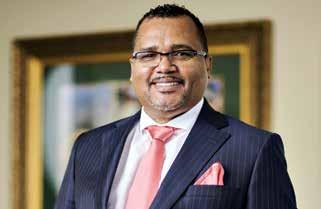
2 minute read
Q&A WITH FRED ARENDSE, FOUNDING PRESIDENT OF THE JUNIOR MINING COUNCIL

Q: WHY DID YOU FEEL THE NEED TO LAUNCH AN ORGANISATION LIKE THIS, WHEN THE MINERALS COUNCIL SOUTH AFRICA ALREADY EXISTS?
A: The objective of the Junior Mining Council (JMC) is not to compete with, but to cooperate with and complement, other industry bodies. To put matters into perspective, although the Minerals Council South Africa (MCSA) has a Junior Mining Help Desk, it also has 77 members representing 90% of SA’s mineral production, which by implication are the major mining companies.
The JMC will have a focused approach to the unique needs of the junior mining sector and members, which is a very diverse group, ranging from artisanal miners to producers with an annual turnover of less than R500-million. It includes mines, natural brickfields, stone quarries, mine suppliers, explorers, contractors, etc. These companies are largely unrepresented, without a voice and support.
Q: WHAT ARE THE CHIEF GOALS AND FOCUSES OF THIS ORGANISATION?
A: The main goal is to address junior issues in a way that these companies can mature and grow for the benefit of the industry and SA as a whole.
The JMC’s key purpose is to represent the interests of the junior mining industry in the mainstream economy through the following:
Uniting all emerging and junior miners, relevant suppliers, contractors, explorers and quarries behind a common purpose and vision for the sector.
To develop and drive relevant programmes of action that position the junior mining sector at the centre of economic growth and participation in SA.
Q: WHAT SORT OF RECEPTION HAVE YOU RECEIVED, AND HOW DO YOU SEE THE JMC ASSISTING JUNIORS, MOVING FORWARD?
A: Following our introduction at the Junior Indaba this year, we found instant support for the establishment of a new voice for the junior mining sector. Without exception the reception has been very positive, to the extent that a number of companies signed up to become members on the spot, while several more expressed interest.
As for assistance, among our objectives are:

■ Attracting and facilitating investment funding for members.
■ Lobbying and improving communication with media, communities, organised labour, government and all relevant stakeholders.
■ Collaborating with government, relevant departments, state-owned enterprises and other professional bodies to advance the junior mining sector in SA.
■ Enhancing and leveraging on available skills and resources, and providing a platform to grow skills and relevant competencies.
■ Providing a platform to enrich and action key policy debates, and creating capacity and capability relevant to the junior mining sector.
Q: WHAT IS YOUR VIEW OF THE CURRENT STATE OF THE JUNIOR INDUSTRY – SPECIFICALLY, THE IMPACTS, THINGS LIKE SUSTAINABILITY, RENEWABLE ENERGY, WORKER SAFETY AND CURRENT GEOPOLITICAL CONCERNS, ARE HAVING ON IT?
A: The junior mining sector sees environmental, social and governance (ESG) issues as something that needs to be addressed, with the JMC providing guidance in this regard. Worker safety is a primary concern and the smaller the operation the bigger the concern.
New legislation specifically addresses artisanal and illegal mining, the latter of which I also see as a form of artisanal mining. The poor safety records of these are especially disturbing and it is an area where I foresee that the JMC can, through third party intervention, play an important role.
As far as geopolitical uncertainty is concerned, risks o en create opportunities – such as the fact that coal exports have increased by 700% since the Russia-Ukraine war, and the majority of the coal mining companies falls within the junior mining category.
Q: ALTHOUGH YOU HAVE JUST LAUNCHED, CAN YOU GIVE US AN IDEA OF YOUR LONGER-TERM PLANS FOR THE JMC?
A: My vision for the JMC is to develop and grow it into a reputable and respected institution, which will stand as a beacon on the global stage in terms of junior mining representation and support.








